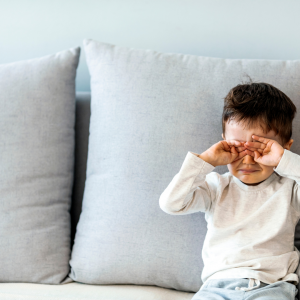
If you are a parent to a young child at least one time or another you have heard the middle of the night cries saying “mama I’m scared”. Today’s blog is going to fill you in on common bedtime and nighttime fears, what ages to expect certain fears, and how to go about managing these fears. Why is it important to manage fears? Because a good night’s sleep means you feel safe, secure, and know that your bedroom is a happy place for sleeping and this is important for life!
When do children develop fears?
Recognizing fear as an emotion happens at a young age, typically by 7-months. Babies pay more attention to faces with fearful expressions and some researchers take this as evidence that babies are beginning to understand the meaning of these expressions. For example, babies don’t pay more attention to angry faces—only fearful ones.
By 12 months babies can understand the meaning of a fearful face as a sign of danger. They are able to use this information to guide their behavior in new situations. For example, if mothers tense their grip on babies after a new toy is offered to them, 12-month-olds spend less time playing with the toy.
By 2-4 years children can use words like happy, angry, and sad to label photographs of emotional expressions. At this age, children understand these emotions, but often “mix up” labels for negative emotions like anger, fear, and sadness (reference: https://www.zerotothree.org/resources/2953-childhood-fears ).
By 4 years of age, scary dreams were common, up to 75% of children can report bedtime fears at some point, and as they grow older worry can become even more prominent in 7- to 9-year-olds (reference: Muris P, Merckelbach H, Gadet B, Moulaert V. Fears, worries, and scary dreams in 4- to 12-year-old children: their content, developmental pattern, and origins. J Clin Child Psychol. 2000 Mar;29(1):43-52.)
How can I tell when my child is having bedtime fears?
An important aspect of bedtime fears is understanding if your child is truly afraid. Young children often can mislabel emotions and it’s up to you as the parent to be the emotion detective. When your child says she is scared does she look frightened? Common things to look for would be if she is crying, shaking, clinging to you, etc. If she is saying I had a bad dream but is calmly stating it then she may be more so requesting an extra sip of water (see my blog on preventing curtain calls here ).
Keep in mind that nightmares happen now and then, if your child is saying she had a bad dream every night then it either is a delay tactic or true anxiety that should be addressed. One way to decipher is to ask your child to describe the nightmare the next day (or draw it out), if it’s a true nightmare or fear they should be able to describe it most of the time- most children that complain about fears nightly aren’t able to describe the dream, usually because there hasn’t been any.
When children wake their parents at night they commonly say they are scared, whether they are or not, it’s up to you (with my help) to be the emotion detective!
Kelsey Alford of Nested sleep
Techniques to help a child feel less frightened

- Arrange for enjoyable time in the bedroom. If your child only sleeps in their room AND now they only have fearful or negative associations with their room then they need to create positive ones. Have a fun quiet time activity they can do in their room during the day time (more ideas here)
- Move the bedtime later temporarily. Make the lights out time close to when your child is actually falling asleep. By making a later bedtime their mind has less time to wander and think about the monsters under the bed.
- Use a bedtime pass (download it for FREE here). The bedtime pass can help if the fear is truly stalling tactic and then there is a reward or prize associated with staying in bed.
- Agree to check on your child periodically. Often times mild fears are related to a child keeping tabs on their parent. This happened in our family recently after our move because our bedroom locations were much different. Tell your kiddo you will check on them in 5 minutes and everynight try increasing the time your do these checks.
- In the beginning assume the fear is real and provide support. If you aren’t making progress then seek professional help to decide how serious your child’s anxiety is to see if counseling is indicated.

References:
Ferber, R. (2006). Solve your child’s sleep problems. New York: Simon and Schuster.
Muris P, Merckelbach H, Gadet B, Moulaert V. Fears, worries, and scary dreams in 4- to 12-year-old children: their content, developmental pattern, and origins. J Clin Child Psychol. 2000 Mar;29(1):43-52.
https://www.zerotothree.org/resources/2953-childhood-fears


